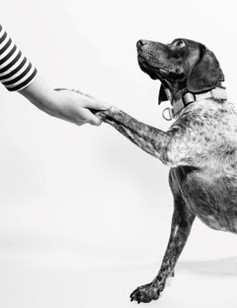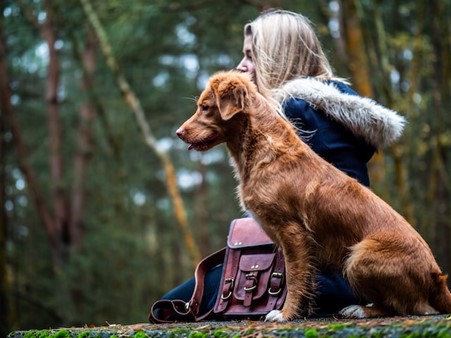Marissa Corbett of Shamong, NJ is the owner of Above and Beyond Dog Training. As a young girl, Marissa had always had a passion for animals. Marissa began her dog training career after enrolling herself and her dog in training classes, where she grew to love the training process and interactions with other dogs. In the following article, Marissa Corbett explains the common dog training mistakes that are commonly made that reinforce bad dog behaviors, how to correct and change those behaviors and how to apply these techniques into real-world settings.
Training a dog takes time, patience, and dedication to reinforce their good behavior. Unfortunately, though, many dog owners make the mistake of thinking that the training process is complete after just a few weeks or months. Just like people, dogs need constant reminders of the rules and expectations that their owners have set for them. If not, they’ll quickly forget what they’ve learned and develop bad habits explains Marissa Corbett of Shamong, NJ.
By getting angry, failing to reinforce good behaviors, and accidentally reinforcing bad behaviors, dog owners can confuse their pets, and undo weeks, if not months of training. However, Marissa Corbett explains that by being aware of these common mistakes, pet owners can remain mindful and help their young dogs learn new tricks, behave inside, and get along with other pets.
Using the Wrong Tone of Voice
When training their canines, dog owners must remember that their pets cannot understand the complexities of human language according to Marissa Corbett of Shamong, NJ. While it’s true that a dog can learn its name and a few dozen words, it cannot differentiate between a praising sentence and a chastising sentence unless there is a clear shift in tone.
Therefore, trainers should be careful to not accidentally reinforce their dog’s behaviors with a praising tone unless the dog deserves praise explains Marissa Corbett. Even saying “Oh no, that’s not right,” will confuse the dog if it’s said in a happy, upbeat tone. Instead, pet owners should use short, simple commands, such as a curt “no” if the dog doesn’t act correctly.
Marissa Corbett of Shamong, NJ recommends developing five clearly distinct tones of voice to help encourage or discourage certain behaviors:
- Praise – A happy, excited tone of voice that is used to let the dog know it has done something good.
- Encouragement – A more subdued tone of voice that is used to encourage the dog to continue his behavior.
- Command – A firm tone of voice that is used to give the dog a specific instruction, such as “sit,” “stay,” or “come.” Marissa Corbett says these command words should be simple, 1-to-2-word instructions.
- Correction – A sharp, stern tone of voice that is used to scold the dog for doing something wrong.
- No Reward – A bored, disinterested tone of voice that is used when the dog does something that is not worthy of a reward.
As the dog learns these distinct tones, they will respond accordingly, regardless of what’s actually being said explains Marissa Corbett of Shamong, NJ.
 Nagging, Shouting, and Getting Frustrated
Nagging, Shouting, and Getting Frustrated
When a dog doesn’t immediately obey a command, it’s easy for owners to get frustrated. Unfortunately, , nagging, shouting, and getting angry will only serve to confuse and scare the dog says Marissa Corbett. Instead of raising their voice, dog owners should try to remain calm and patient. If the dog doesn’t obey the first time, try again. This is an endless process that doesn’t always end in the puppy stage. Older dogs may need this consistent reinforcement even as they age.
If the dog still doesn’t listen, try using a different tone of voice or using a hand gesture to help get the point across. It’s also important to remember that dogs learn at different speeds reminds Marissa Corbett of Shamong, NJ. Some dogs will pick up new commands quickly, while others will need more time and repetition. This does require patience but, with some dedication, any dog can learn new tricks.
Not Applying Training to Real-World Situations
Many dog owners make the mistake of only working on obedience commands in a controlled environment, such as their living room or backyard. While it’s important to practice in a safe, familiar place, it’s also essential to take the training out into the real world.
Marissa Corbett of Shamong, NJ explains that dogs need to learn how to behave in a variety of different situations, such as when there are other people or animals around, when there are distractions, or when they’re in a new place. The best way to do this is to slowly introduce the dog to new environments, starting with places that are not too overwhelming.
For example, a dog owner may choose to reinforce a few basic commands at home and then apply them in a real-world scenario by taking their dog for a walk around the block.
If the dog can respond to sit or stay commands while the world goes by, the owner could then try taking their pet to a park or on a hike. In time, the dog will learn to always respond to their owner and proper dog behavior.
Final Thoughts
Dogs are intelligent creatures that can learn a variety of new tricks and commands. However, they need to be properly trained in order to do so. By being aware of common training mistakes, pet owners can avoid potentially confusing signals and help their dogs learn to sit, stay, come, and behave in a variety of different situations.







